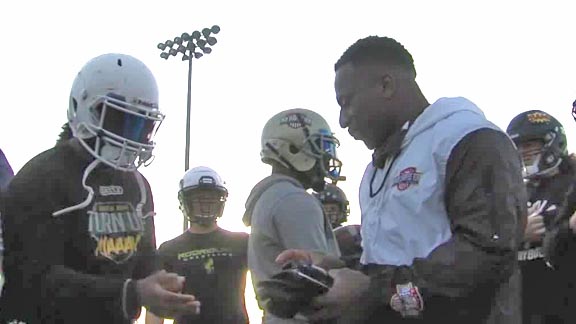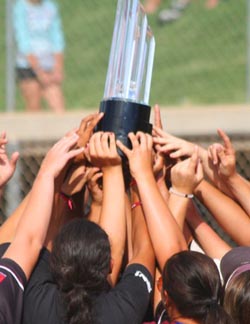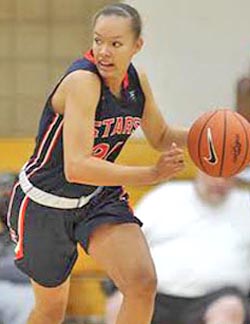
Players surround coach Derrick Stevens of the IronSharpensIron Football Academy, a club team, during a practice held in Elk Grove recently. Photo: fox40.com.
With high school football still in danger of not having any season for the 2020-21 school year at all taking place in many parts of the state, operators of club football teams have stepped into the gap. Games have been held going against local and state health restrictions and club teams have been traveling to out-of-state competitions. Once the pandemic is over, however, does club football have a future alongside the traditional CIF high school landscape? If they become more like the great club teams we have in the state in other sports, then yes. Go inside as well for a look at high school vs. club arguments in other sports.
Note: We hope you enjoy this free post on CalHiSports.com. We’d love to get back to covering actual accomplishments by players, teams and coaches on the field, but the coronavirus pandemic is emerging from its worst surge so far and it still seems like the planned start of football is not going to happen for many weeks. To check out getting a Gold Club membership to see all of our state record updates (five sports), totally authentic historical features, recruiting ratings and more, CLICK HERE.
As we’re posting this column on the day after teams will be determined for this year’s Super Bowl, the coronavirus pandemic in California continues to be in a perilous period. While infections and hospitalizations are trending downward from the holiday surge and the state has lifted stay-at-home orders, deaths continue to be ravaging and at numbers not seen since the pandemic began. The El Monte Unified School District, located in hard-hit Los Angeles County, also has announced it is cancelling its Season 1 (or fall sports) for athletics but is hoping that Season 2 (spring sports) can still be played.
On the other hand, momentum for the #LetThemPlayCA movement plus work done by prominent football coaches in the state seems to be gaining traction. Organizers have done a good job building on the support they’ve received since the more than 100 rallies were held throughout the state on Friday, Jan. 14. Head coaches Patrick Walsh (San Mateo Serra), Justin Alumbaugh (Concord De La Salle) and Ron Gladnick (San Diego Torrey Pines) met on Sunday with Jim DeBoo, who is the person in Governor Gavin Newsom’s administration who oversees all of its various priorities and sets the schedule for the Governor.

One of the greatest club/travel programs in state history is the OC Batbusters in softball, which has been going since 1979 and has won numerous national titles. Photo: flosoftball.com.
The answer to the question regarding club football, which also has become a major topic on social media as the high school teams are shut down, depends on what those running the club football programs do in the future. If they follow the model of travel ball teams in softball or club teams in boys/girls basketball, girls volleyball or many other sports, then the clubs of the future in football could serve as a nice complement to high school football. If they go more rogue, and look to their model as more of a replacement for high school football, then club football is going to have a hard time surviving. High school football just has too many built-in advantages.
To be clear, what we’re talking about here is not the same thing as a current high school perhaps playing as a club team later this school year as an alternative to a regular high school team. We’re talking about tackle football club teams that are playing in Riverside County and in the Central Valley.
To help parents and student-athletes understand the role of club vs. high school, here’s a list of beneits for each and why when they are conducted with some level of cooperation they can both provide positive experiences for the athlete. We’ve written a version of this column before on other platforms, the first time in the early 2000s for Student Sports Magazine.
1. Club competition can be more challenging. This isn’t true if the football player is at a school in the CIF Southern Section’s Trinity League or CIF Central Coast Section’s West Catholic Athletic League, but if the player is at a small school then the competition from practices and games for a club can be better and more productive. We’ve written up many stories about girls from small towns traveling hundreds of miles to play for a club team. Perhaps the most famous is women’s soccer icon Megan Rapinhoe, who went from her home near Redding down to Elk Grove near Sacramento to play for her club team.
2. Club competition is much better for college recruiting. For right now, yes it’s against health orders that club football games can even be played, but from the film we’ve seen of the players in those games it’s just as good as film you’d see from a high school. Of course, right now no one is getting themselves on film at a California high school game. In other sports, the club competitions are often tailored for college coaches to come and watch. They’ll come because they can see a lot of players in one place. You won’t see college coaches going to any high school games (other than Mater Dei vs St. John Bosco or similar). Some of the games can be scattered with a lot of players doing one-on-one moves in other sports, but college coaches are confident they can take a player they like and develop them into better players and players who can show they know how to play within a team concept. A college coach, who has to have some level of success (wins vs. losses) to keep a job, would be silly not to look for players in club competition. We’ve heard parents and some players say club is where someone gets recruited and high school is for fun. That is definitely true for some players in many sports.
3. High school sports can connect the player with their communities. While players in clubs can come from anywhere, the high school is representative of the towns and communities they are in. Why do newspapers cover high school teams with results, rankings and more? One reason is because there are literally thousands of alums from the high school in their communities who are interested in how the teams at those high schools are doing. No one could care less how a club team is doing even if the club is located in their town. The same connection also works both ways as the high school athlete knows all too well that he/she is representing the community in which they live.
4. High school can be the place where the player makes a name for himself/herself. Whenever players from a particular club/travel ball or similar does well at the next level in college, where they went to high school is almost always mentioned first by college sports information offices and in the media. The club teams also don’t have local honors such as players of the week, all-area teams, all-county teams or all-league teams that can be added to someone’s athletic resume. Larger honors, such as the all-state teams we have done for more than 40 years, plus All-American teams, Gatorade players of the year and more are all for high school players. We’ve seen some vertical sites such as in softball and volleyball provide rankings of club teams, but for individual recognition beyond the recruiting rankings that’s about it for the clubs. Clubs also don’t have any school records, state records or CIF section records being maintained and updated.

The infused experiences between club and high school competition is also demonstrated successfully in girls basketball. In photo above, Valerie Higgins (previously at Chaminade of West Hills) is shown playing in 2015 for the CalStars AAU/club team. Photo: Courtesy CalStars.
5. High school coaches are often paid and trained as teachers first. This isn’t to say that a club coach can’t do a great job, but it’s hard to know what background a club coach might have. The vetting process between the two is much different. Even a walk-on coach at a high school has to go through steps before he or she is allowed to be working with kids. Plus, as we’ve known from the many high school coaches we’ve covered over the years, they’re more interested in teaching life lessons to their players than collecting wins or championships.
6. The pageantry of high school football on a Friday night can’t be beat by a club game with more limited attendance. Yes, there are many high schools in more urban settings where the crowds are sparse and in which games have to be played in the afternoon. But at most schools the added participation of bands, rowdy student rooting sections and cheerleaders provides an atmosphere that makes some folks keep coming back to the games even after their own kids have graduated.
7. The bond between club teammates seems to be just as strong or stronger than it is for high school teammates. Some of those friendships for high school players have been going on since grade school, and that can create special memories when playing together. Club teammates, however, usually spend a lot more time together and they are often similar in their desire to train and get better. Their families also get close by traveling to the same events, eating out together, and more.
As you can see, there are benefits for any athlete to consider both situations of playing high school sports and being in a well-run club program. For the sports we follow the closest, it’s almost always different club seasons as high school so it is possible to do both. The two do go hand-in-hand and we know of some coaches who are at high schools and also run club programs.
Future Possibilities For Club Football
A California Interscholastic Federation switch in its guidelines released last week forbids players from being on a club team or high school team at the same time. The initial rule earlier in the pandemic when calendars and seasons were set last summer was to allow that to happen. This year is obviously unlike any other with possible football games in March and early April and basketball possibly going until early June. But the California Department of Public Health has said that a high school player can’t be involved in two different cohorts at the same time. Once the calendar returns to normal, we wouldn’t think a rule about club vs. high school would matter since the seasons for each sport will go back to being at different times of the year.
None of the club football games that have been played illegally according to state guidelines seems to draw any sanctions from the state government, but it’s not as if the state won’t be able to find video of all of these games. Club teams at some point could face fines and/or legal costs and more difficulties for playing against local county health rules. Being that much against rules and laws such as those will be appealing to some parents and players, but just as many will be turned off to that approach.
Positioning itself as a replacement for traditional high school football (and doing it aggressively on social media) seems to be more for those looking to make a quick buck during the pandemic and not for the long term. A strong club football team, however, could be an alternative for those athletes of the future who may not even have a football team at their high schools. It also could be easier for an organization or club that already has tackle football teams in lower age groups (12-under to 14-under) to add programs for older players.
Should a family in the future from a school that only has a few kids playing football automatically have to pay a private school tuition or move in order for those kids to play at all? In those situations, a club football team consisting of a few players from several schools in a region definitely could become a viable option.
And for a final question, can club football with tackling and pads become a staple of the spring alongside the 7-on-7 teams that also have popped up over the last 10 years? For some athletes who are not skill players, then it’s easy to see that the answer is yes. As for recruiting in football, it is different than other sports because there are a lot of combines, camps and showcase events in which the regular high school player can take advantage of. The developing football player therefore in the future could have spring choices that include track-and-field, a private 7-on-7 program or a club football team with tackling. And if all choices provide a positive experience, there’s nothing wrong with that.
Mark Tennis is the co-founder and publisher of CalHiSports.com. He can be reached at markjtennis@gmail.com. Don’t forget to follow Mark on the Cal-Hi Sports Twitter handle: @CalHiSports




